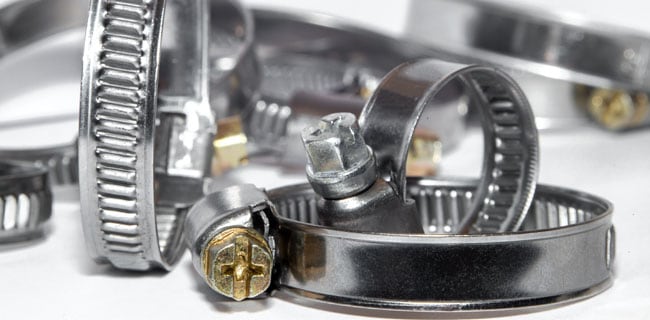Clamps are fastening devices used to secure objects tightly together to minimize movement and prevent separation. This, you know. But did you know all the different varieties of clamps that exist? For general work holding needs, clamps are available in endless variations to accommodate nearly any application. Whether you need reusable clamping devices or economical one-and-done versions, there is a clamp to help you ensure an effective and secure connection. Curious what clamp is right for your next job?
Automotive Clamps: Automotive tubing and hose clamps are typically used in fleet applications where heavy-duty clamping of hoses is required. You’ve likely seen these circular clamps on radiator hoses. Often made of stainless steel to protect against corrosion, these clamps can be tightened with a screwdriver, nut driver or socket wrench.
Hose Clamps: Hose clamps are used to hold tubes or hoses. Hose clamps are available in different specifications including various clamp types, diameters and materials such as plastic or metal. Hose clamps are ideal when fluid is conveyed through the pipe or hose and a flexible and removable connection is desired.
Band Clamps: Band clamps typically have a strap that can be adjusted to hold circular, angular or irregularly shaped objects in place.
C-Clamps: C-Clamps are usually used to hold wood or metal workpieces in applications such as carpentry and welding. The name comes from the C-shape of the clamp itself.

Pipe Clamps: Pipe clamps are ideal for use when hanging or securing pipe. Pipe clamps are often used in piping or plumbing applications such as securing exhaust pipes, guard rails, conduit or other piping.
Material Holding Clamps: Material holding clamps are used to hold heavy material while it is lifted or maneuvered. Keep in mind the load capacity and load orientation of your workpieces before selecting a material holding clamp.
Cable Clamps: Cable clamps are ideal for bundling, securing, lifting or rigging multiple cables and cords. Cable clamps are often used when manufacturing items to route cables or cords and minimize stress and damage. Cable clamps are available in many diameters, materials and mounting options.

Hand Clamps: Hand clamps are used to position and hold workpieces during assembly or manufacturing processes. Different applications call for various clamp options, including grip range and other clamp features. Hand clamps are available in various options and include bar clamps, draw clamps, parallel clamps or toggle clamps.
Ground Clamps: Ground clamps are important devices when securing grounding wires to ground rods and pipes. They can also be used to create a ground path for electrical currents during a short circuit or ground fault.

Preformed Clamps: Preformed clamps are used to eliminate leak paths in thin-wall hoses. These can be made from various materials including galvanized steel, stainless steel and galvanized carbon steel.
Pneumatic Clamps: Pneumatic Clamps are clamps that combine a pneumatic cylinder with a toggle mechanism and are used to hold workpieces in place. Electrical Clamps: Electrical clamps are clamping devices with jaws that open and close on electrical conductors to measure current and voltage. Ideal for use in applications when disconnection or de-energizing the electrical system is to be avoided.
Related: Industrial Hose Maintenance: How to Inspect for Wear Points on Your Hose Assembly
Have questions on improving the safety and efficiency of your operation?
Give us a call at 314-638-6500 OPTION 4.
Things to consider when making your next clamp selection:
1. Desired Material
Choose your clamp material wisely. You’ll want to consider things like environments, conditions, as well as the presence of electricity, water, humidity, oils or extreme temperatures. Clamps are often available in materials such as:
- Galvanized Steel
- Stainless Steel
- Steel
- Cast Iron
- Silicone
- Plastic
- Nylon
2. Maximum Clamping Force Needed
Clamping force is how much force a clamp face will apply to an object and it is usually measured in Newtons(N) or pounds(lbs). Be sure to check the maximum amount of force that your workpiece, cable, hose or pipe can sustain without damage to the piece or the clamp itself.
3. Load Capacity
In addition to maximum clamping force, you’ll want to consider the weight of the workpiece, cable, hose or pipe, and whether or not it will be suspended in the air. Load capacity can be expressed by pounds or tons.

Related: How Superior’s Rigorous Training Programs Impact The Customer Experience
Still not sure what clamp, hose or fitting your job needs? Our team of specialists can help you select the right products to get you back to work quickly and effectively. We carry many types of clamps and other work holding supplies from brands like Danfoss Power Solutions, Parker, Breeze, Gilmour, Kuriyama, Snap-Tite and more.
Give us a call at 314-638-6500 OPTION 4 and speak to a knowledgeable representative today!
Superior Industrial Supply knows how important it is to have durable and reliable equipment for your most demanding applications. It’s why we specialize in hydraulic hose assembly and repairs. Give us a call at 314-638-6500 OPTION 4 or 800-783-6501 and let us know how we can help you find the products, services and advice you need to do just that.
Don’t forget to read our blog for more information!

